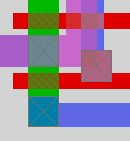

|
Magic Mailing List |
|
From: Jeff W. Sondeen (sondeen AT rcf-fs DOT usc.edu) Date: Mon May 22 2000 - 12:45:29 EDT
Andrew Lines writes:
> This is a multi-part message in MIME format.
> --------------BAEB9CDB04944B283676C6A7
> Content-Type: text/plain; charset=us-ascii
> Content-Transfer-Encoding: 7bit
>
> I fixed a subtle bug in the cifSquareFunc (which generates the cut
> pattern for magic contacts). The code assumes that the magic contact,
> cut size, and cut spacing are all even centimicrons. Unfortunately for
> lambda = 0.09um, this doesn't always hold. The routine can't center the
> cut pattern exactly in the magic contact. Therfore, overlapping
> contacts between different subcells may generate inconsistent cuts.
> This is impossible to completely avoid with an odd lamba (except by
> adding a highly inconvenient no_overlap design rule for contacts!)
>
> However, the problem can be mostly solved by changing cifSquareFunc to
> find the center of the square by trunctating toward negative infinity,
> instead of toward zero. At least this lets you overlap contacts between
> cells which haven't been flipped upsidedown or sideways with respect to
well, this is not a good idea (when allowing contacts to overlap
between cells) since it allows magic to (possibly) generate bad
contacts when contacts overlap between cells with non-identity
orientations (as you point out below).
> each other. This works great for arrays elements which share contacts
> (which is the most common place you would do that).
>
> We run our layout through Mentor Graphic's Calibre program before
> submitting it, so is acceptable for us to catch uncommon errors that
> slip past Magic. If you want to solely use Magic for DRC checking,
> you'd better avoid odd lambdas or overlapping contacts!
yes, but it's not just odd lambdas -- the problem can happen whenever
magic contact sizes aren't exact multiples of size/space/overlap (and
overlap across cells at non-identity orientations).
maybe we need a new rule -- that contacts must be an exact multiple of
size/space/overlap -- so that your approach could be incorporated into
magic generally.
/jeff
>
> Here is the new code in cif/CIFgen.c. (Rajit, could you explain how to
> work your Magic cvs repository?) By the way, I did NOT fix
> cifSquareGridFunc because I don't use that, but perhaps somebody should
> to keep it consistent.
>
> int
> cifSquareFunc(tile, op)
> Tile *tile; /* Tile to be diced up. */
> CIFOp *op; /* Describes how to generate squares. */
> {
> Rect area, square;
> int i, nAcross, j, nUp, left, xcenter, ycenter;
>
> TiToRect(tile, &area);
>
> /* Compute the real border to leave around the sides. If only
> * one square will fit in a particular direction, center it
> * regardless of the requested border size. If more than one
> * square will fit, then fit it in extras only if at least the
> * requested border size can be left. Also center things in the
> * rectangle, so that the box's exact size doesn't matter. This
> * trickiness is done so that (a) coincident contacts from
> overlapping
> * cells always have their squares line up, regardless of the
> * orientation of the cells, and (b) we can generate contact vias
> * for non-square contact areas, for example poly-metal contacts
> * in the MOSIS CMOS process.
> */
>
> /* AML: round center of area toward -infinity to be consistent for
> odd centerings */
> xcenter = area.r_xbot + (area.r_xtop - area.r_xbot)/2;
> ycenter = area.r_ybot + (area.r_ytop - area.r_ybot)/2;
>
> nAcross = (area.r_xtop - area.r_xbot + op->co_bloats[2]
> - (2*op->co_bloats[0])) / (op->co_bloats[1] + op->co_bloats[2]);
> if (nAcross == 0)
> {
> left = xcenter - op->co_bloats[1]/2;
> if (left >= area.r_xbot) nAcross = 1;
> }
> else
> {
> left = xcenter + (op->co_bloats[2] - (nAcross * (op->co_bloats[1] +
> op->co_bloats[2])))/2;
> }
>
> nUp= (area.r_ytop - area.r_ybot + op->co_bloats[2]
> - (2*op->co_bloats[0])) / (op->co_bloats[1] + op->co_bloats[2]);
> if (nUp == 0)
> {
> square.r_ybot = ycenter - op->co_bloats[1]/2;
> if (square.r_ybot >= area.r_ybot) nUp = 1;
> }
> else
> {
> square.r_ybot = ycenter + (op->co_bloats[2] - (nUp * (op->co_bloats[1]
> + op->co_bloats[2])))/2;
> }
>
> for (i = 0; i < nUp; i += 1)
> {
> square.r_ytop = square.r_ybot + op->co_bloats[1];
> square.r_xbot = left;
> for (j = 0; j < nAcross; j += 1)
> {
> square.r_xtop = square.r_xbot + op->co_bloats[1];
> DBPaintPlane(cifPlane, &square, CIFPaintTable,
> (PaintUndoInfo *) NULL);
> CIFTileOps += 1;
> square.r_xbot += op->co_bloats[2] + op->co_bloats[1];
> }
> square.r_ybot += op->co_bloats[2] + op->co_bloats[1];
> }
>
> return 0;
> }
>
>
> --------------BAEB9CDB04944B283676C6A7
> Content-Type: text/x-vcard; charset=us-ascii;
> name="lines.vcf"
> Content-Transfer-Encoding: 7bit
> Content-Description: Card for Andrew Lines
> Content-Disposition: attachment;
> filename="lines.vcf"
>
> begin:vcard
> n:Lines;Andrew
> tel;fax:(626) 844-2951
> tel;home:(626) 568-4928
> tel;work:(626) 844-2941
> x-mozilla-html:FALSE
> url:www.avlsi.com
> org:Asynchronous Digital Design Inc.
> adr:;;1010 E. Union #202;Pasadena;CA;91106;USA
> version:2.1
> email;internet:lines AT avlsi DOT com
> title:Founder
> x-mozilla-cpt:;11936
> fn:Andrew Lines
> end:vcard
>
> --------------BAEB9CDB04944B283676C6A7--
|
|
|

|